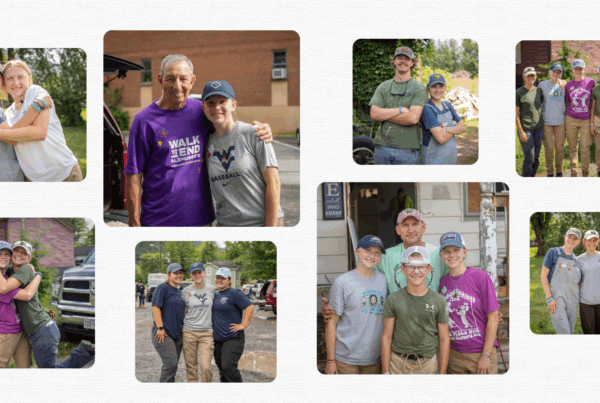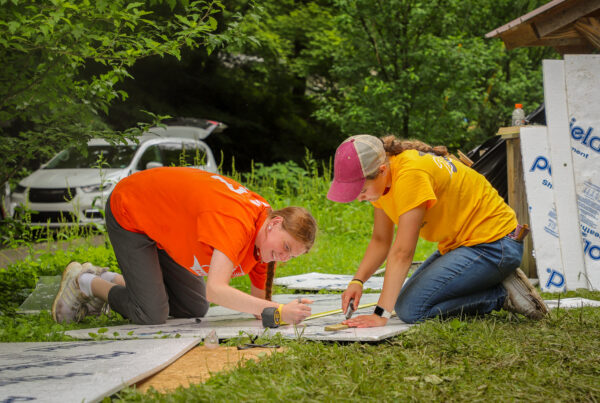This week I visited Knott County and stayed with the staff at the center in Carrie, KY. We had a great time meeting homeowners and watching fireworks, petting dogs and eating delicious Brown Butter Cookies from a local store called Yoder’s. Alongside these fun things was a lurking awareness of the flood that swept through almost a year ago.
Gurgling, Trickling Creeks
I’ve always loved creeks. In my elementary school years, a good friend had a creek behind his house. Not knowing if we were technically allowed beyond the bark-lined border, we would creep through the sleepless defenses of the oaks and maples keeping watch. We’d make our way to the creek and down its stream to accomplish some imagined mission that the fate of the world depended upon. There was something exciting and playful about the rushing gurgles we ran past and hopped over.
Creeks have also calmed me over the years. The college I went to was built on a hill, and snaking around its base is Buffalo Creek. When assignments, or whatever else, got to be too much I’d sneak away, creeping through the close watch of sleepless classroom buildings and to the creek. Buffalo Creek is about 15 feet wide and 6 inches deep with the smallest of riffles from the biggest of stones. Its steady trickles calmed my nerves.
The center in Carrie is at a church building, and Troublesome Creek wraps around it. The creek is about the same width as Buffalo Creek but deeper, at least where we were. A few times this week I walked along its bank and found the calm that creeks usually offer. In Knott County it seems like everywhere you go there’s a creek on your left. And if there’s not, it’s on your right. If you had asked me to design a perfect place, there’s no doubt it would include creeks like Knott County’s, with all their gurgles and trickles.
But this week my response to gurgles and trickles began to change. Not so much that it’s completely different, but enough that calm wasn’t all I felt when I heard a creek close by. This week I would take a second and third look, imagining what it must have been like to see and feel those trickles and gurgles rise over the banks.
I had heard about the floods in Kentucky last July. But hearing about something like that is much different than hearing people who lived through it. And it changed the way I heard the creeks around me.
Guggles in the Holler
One homeowner had been warned by her daughter that flooding was a possibility. She looked outside from her porch and saw a low stream of water coming into their holler. But that wasn’t anything she hadn’t seen before. She assumed it wouldn’t get much worse and returned to bed. Later, the water’s persistence pulled her out of sleep. She said she heard a “guggle” from beneath the floor. Eventually the water guggled up through the floor vents.
She said she didn’t worry about any of her belongings. All she could think of was her dog and her sleeping neighbor. She delivered the dog to safety and left to knock on her neighbor’s door. Eventually she woke up, and they joined the others on a hill above the holler. Just about every neighbor she mentioned had pets, and all of them—pets and people—escaped the chest high water that invaded their holler.
Retiring at Home
I met several dogs this week, and three of them were at one home. Their owners are Chris and Lori. Chris is big into disc golf, which he’s been playing since the 1990s. Lori makes quilts and loves to do it. Most recently she made one for her newborn grandson. The couple followed her mother to Knott County. She had grown up in the area but moved to Florida to work. When she retired she came back.
“She was tired of the hustle and bustle,” Chris said. “And she wanted to move back to where she came from and its nature.”
Chris and Lori moved into their current house to help care for her mother, and they’ve been living there ever since.
Huddling Together
After going to sleep on the night of July 27th, they heard a knock at the door at one in the morning. It was their neighbor, who told them water was coming down the road. When Chris and Lori stepped out onto their porch, the water below them was ankle deep.
Their car was out front, and they thought about escaping down the road. But, they realized, even if they outran a lot of water, who knew what they’d find farther down. Before they could make a final decision, it was made for them. Their car, with Chris’s favorite disks inside, was swept away.
The water approached chest level, and they all, Chris said, congregated in a bedroom—Chris, Lori, their daughter, and their three dogs. The three humans kept safe on the mattress. And Christ took a door off its hinges for the dogs to float on. Each time they noticed the water rise, they marked it on the wall. They stayed there huddled together as the water continued rising.
Their bedroom window looks out to the neighboring building, a mechanic’s shop, that keeps cars out front. As they sat there, the cars were overtaken, and a few rolled right in front of their front door. With the closest door blockaded, they worried about getting out of the house eventually. They began tearing out the ceiling in case they needed to escape to the roof.
Possibly the biggest fear came when a newly bought, 500-gallon propane tank was pulled from the ground. They sat there for hours, listening to the propane add its whistle to the sound of rushing water. It sat in their backyard for a while before being swept down the road.
Chris said, “I’ll tell you what, I’ll never underestimate the power of water again.”
After a full night of sitting together, the water began to subside. They made their last mark on the wall. Nearby family came to get them, and they all got out through the bedroom window.
“It ended up working out that we couldn’t leave,” Lori said. “It must’ve been what we were supposed to do.”
Mucking Mud and Hanging Drywall
After a while, they bought a camper and lived in it on their property. They began mucking the water and mud from their house.
“There was so much mud,” Lori said. “Even now we sometimes find it in a nook or cranny every once in a while.”
They’ve gotten a lot of the house cleaned up. As we talked, ASP volunteers were hanging drywall in the house. They’re hoping to return to living in the house that Lori’s mother had made into their home. They said they’re most excited to have family over, especially during the holidays.
“And we just added another grandchild,” Lori said. “So that makes it even more exciting.”
Chris and Lori’s story helped me to better understand the devastation of the flooding in this region. People’s homes were turned inside out by the water, and they have been working to rebuild them.
Their story also taught me what is needed to come through such difficulty. First, you need to get through the initial disaster. You need neighbors who care enough to knock on your door. You need to be able to think quickly: Let’s not drive away, we don’t know what we’ll find farther down and thinking to take the doors of their hinges for extra flotation devices. You need people with boats who are willing to go back into the flood to rescue people from their roofs. You need donation centers and emergency housing. You need a camper to stay in for a while. You need to just get through it.
But Chris and Lori also show what needs to be done after you get through it. Water needs mucking. Floors need cleaning. Foundations need repairing. Drywall needs hanging. Homes need rebuilding.
The region still has a lot to rebuild. And that doesn’t just happen in a few months. Often a disaster like this is given temporary fixes when long term attention is needed. FEMA disaster recovery centers closed in November of 2022. As an emergency response agency, they cannot stay forever. But many people will be left without housing and in need of a permanent residence. Others want and need to return to their homes, but the damage needs to be repaired to last.
Staying afloat—with doors or whatever else—is needed, but drywall needs hanging when the water subsides.
For more information about Eastern Kentucky floods and to offer support, visit https://asphome.org/ky-rebuild/#learn-more
Isaac Wood
Story Gathering Intern




